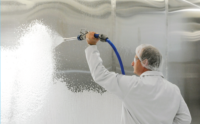Situation
The use of machine vision technology in America is steadily growing. Every year, more industries are turning to the technology to increase the accuracy and efficacy of their inspection methods. Companies stand to benefit from its implementation in areas where automating detection processes would cut costs and time. As the use of application-specific machine vision technology continues to expand, companies are becoming more creative in the ways they seek to incorporate it into their practices.
A few years ago, IDEXX—a biotechnology company specializing in diagnostic products and services—ran into an obsolescence issue when the camera in their SNAPshot® reader neared its end of life. The device served to analyze the company’s line of SNAP® Residue and Contaminant Tests in order to detect antibiotic residue and contaminants in milk. In the U.S., it is required that processors perform testing for beta-lactam antibiotics before processing milk. In many areas outside of the U.S., testing occurs prior to off-loading the milk from transport trucks. Dairy farms, dairy processors and milk consolidation stations worldwide depend on the reader to accurately examine and ensure that milk is safe for consumption.
Although the tests can be read visually, there is often a regulatory or commercial need to have an electronic and/or printed result. The SNAPshot DSR® allows testers to have negative or positive results determined for them in an efficient manner. In need of a new camera for the device, IDEXX partnered with JADAK—a leader in machine vision barcode and radio-frequency identification technologies—for a solution.
Solution
Rather than using an off-the-shelf or industrial camera and risking obsolescence issues all over again, JADAK took a different approach. The team understood that what its partner truly needed was a product with longevity that its customers could rely on; hence, JADAK integrated a camera that is purpose-built to have a longer product life. The JADAK camera is used to take a picture of the SNAP® test strip and JADAK’s engineering team then created a machine vision algorithm for spot detection on the test strips to correctly determine if they were positive or negative. Finally, the team designed the hardware, manufactured and fully assembled the new module on IDEXX’s behalf.
The efforts resulted in the next generation SNAPshot DSR reader. “We deliver viable and longstanding solutions, backed by our full support throughout the life of the product. Our mission is to build partnerships with our customers,” says Eva Gravius, vice president of engineering with JADAK. “We take great pride in developing solutions that will facilitate their continued success.”
Results
With the improved device, IDEXX obtained an integrated solution. The highly durable reader is equipped with a touch-screen display, printer compatibility, SNAPconnect software that allows for data management, and the option to choose one of eight available languages: English, French, Portuguese, German, Italian, Spanish, Chinese and Japanese.
“Choosing JADAK was instrumental to achieving the results we required—all from a single source. Our customers around the globe can test with ease and be confident that they will not have to replace their equipment any time soon,” says Bill Lane, operations manager with IDEXX.
The adaptation of a camera-based machine vision device for diagnostic applications is just one of the attractive options available not just for the agricultural field, but also for the veterinary, medical and other industries seeking to streamline their methods to scan, inspect, track and solve. Companies that provide these services will be pivotal in aiding industries where automation will no longer be a commodity, but a necessity.
John Prior, marketing manager at JADAK, says, “In addition to published growth rates for the global machine vision market of 12.51 percent, we’re seeing increased activity amongst medical device manufacturers using machine vision for applications such as pill counting, lateral flow assay diagnostics, and item inspection, to name a few.”
For more information, visit JADAKTech.com and IDEXX.com.




